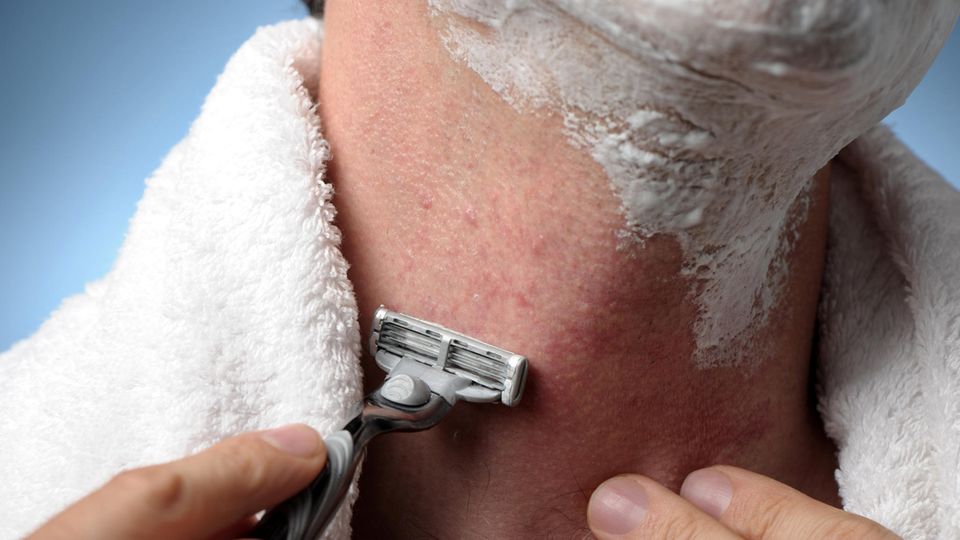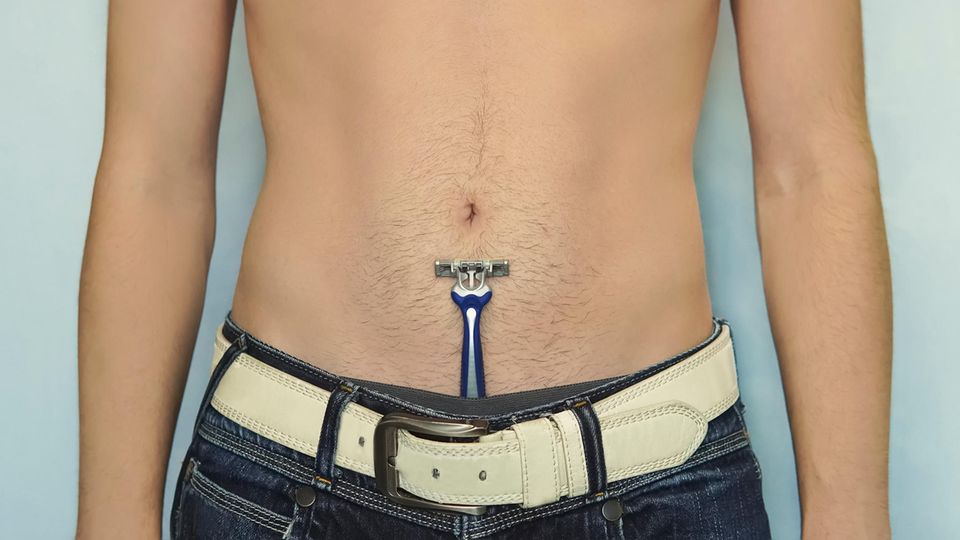skin irritation
How to treat razor burn properly – and prevent it
After shaving, the skin of many men is severely irritated
© mheim3011 / Getty Images
Beard hairs grow incessantly: They manage up to four millimeters every day – much to the chagrin of many people who prefer smooth skin and have to shave every day. The result is a painful razor burn.
Regular shaving permanently irritates the skin and reacts accordingly: redness, skin rash and itching are among the typical symptoms of razor burn, which are particularly noticeable on the neck. But how does such skin irritation come about? This is due to the missing horny scales, which were removed by the razor blades – they normally protect the top layer of skin from external influences. As a result, there are numerous minor injuries such as cuts, which can easily become infected. It is all the more important to properly prepare the skin for the forthcoming shave and to care for it afterwards. This is the only way to avoid razor burn. What you need to consider is explained below.
Avoid razor burn: How to prepare the skin
You should take your time for a close shave. The less you prepare your skin for the upcoming procedure, the higher the risk of a painful and itchy rash – don’t be stingy here. Instead, it’s best to do the following:
This may sound strange at first, but it is a tried and tested method used by beauticians: Place a warm, damp washcloth on the parts of the body you want to shave for two minutes – this opens the pores and makes it easier for you to remove the hair. You can also use a pre-shave product (e.g. a shaving oil or one cream) applied to the skin, which acts as a protective film. This also applies to wet shaving and dry shaving.
If you prefer wet shaving, you should always have one shaving cream or shaving gel use. Apply the product generously and massage it into the skin – this allows the blades to glide more easily over the skin. As a rule of thumb, the more time there is between application and the actual shaving, the less irritated your skin will be. You can then use some aftershave or a skin-friendly Aftershave balm Instruct.
When shaving, you should always make sure to go with the direction of growth. If the blade is sharp, your skin will be just as smooth as if you shave against the direction of growth – it just reacts much more relaxed to it. For the same reason, it is at least as important that you Sound replace them regularly – if they are too dull, they no longer slide over the skin. In addition, germs stick to the old razor blades over time, which in turn trigger inflammation on the skin.
And the pressure also plays a decisive role when shaving: In order to get every hair individually, many people press their razor too hard on the skin and thus irritate it completely unnecessarily. Pay attention to an even, not too strong pressure – the razor blades do the rest all by themselves. Because even if thick whiskers require more pressure than thin ones, you should find a healthy middle ground.
After shaving, the skin must be freed from all care products, preferably with clear water. You can then use an aftershave product (such as a lotion) to soothe and soothe the skin. If you have sensitive skin, the product should never contain alcohol, otherwise it will promote razor burn. Do you have a suitable one balm found, stay tuned! Frequently changing products irritate the skin.

Many men shave their beards daily and suffer from skin irritation
© EHStock / Getty Images
Treating razor burn: you need to pay attention to this
If it is already too late to avoid razor burn, the symptoms must be alleviated quickly. For you, this means first and foremost: If possible, the skin should not be shaved until it has recovered. To speed up this process, you can use the following tips:
Cool the affected areas with an ice cube or a cooling pad – the pores close again due to the cold water. The skin must then be dried very carefully; avoid any form of friction here. It is best to dab the shaved areas with a dry cloth. Then you can Aftershave balm (important: without alcohol) to soothe the skin.
Alternatively, there are also tried and tested home remedies for razor burn, such as honey: the polyphenols it contains have an anti-inflammatory effect. Or you can mix up a face mask – all you need is some quark, chamomile oil and again bee nectar. Mix all three ingredients together and rub it into your skin. After 10 to 15 minutes, the itching should subside.
Baby powder, which is also used in many waxing studios, is just as skin-friendly as it is effective. It contains zinc oxide, which has an anti-inflammatory effect on the skin and can quickly relieve razor burn. When buying, however, make sure that in the baby powder No talc is included – it is said to have a carcinogenic effect.

Razor burn is particularly painful in the intimate area
© Diy13 / Getty Images
Razor burn after intimate shaving: what helps?
Especially in the intimate area, a razor burn can be very uncomfortable and painful – especially if you use the wrong care products. Be sure to choose a product that is free of parabens, allergenic fragrances and dyes. Rather take one instead Intimate Hygiene Gel, which was specially developed for men’s intimate areas. Home remedies such as honey and quark have no place here, but chamomile and aloe vera do: Both components have a calming and anti-inflammatory effect. On top of that, you prevent even more friction with your protective film. The same applies to loose clothing – as long as you suffer from a razor burn in the genital area, it is advisable to avoid tight-fitting textiles. It is better to wear loose and airy clothes until your skin has completely calmed down.
What to do with ingrown hairs?
Ingrown hairs in the intimate area are particularly annoying and can become a serious problem. Try to carefully remove them with tweezers (disinfect beforehand!) – if this is not possible, one can train ointment help. This is rubbed onto the ingrown hair and covered with a plaster to allow the wound to heal. If none of the tips help or if the first signs of inflammation become noticeable, you should consult a dermatologist. Otherwise, you risk developing a boil from the ingrown hair, which can only be surgically removed. It’s a long and painful process that you can avoid by taking the appropriate precautions.
You might also be interested in:
This article contains so-called affiliate links. Further information are available here.

